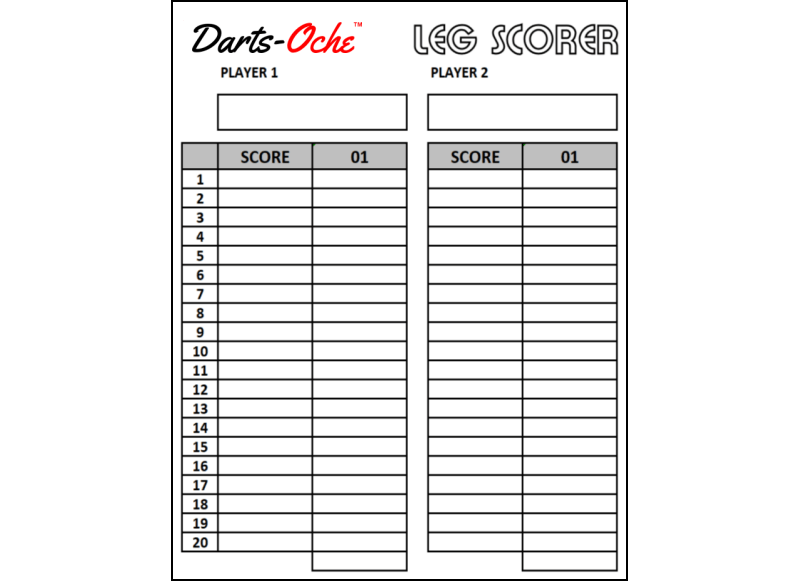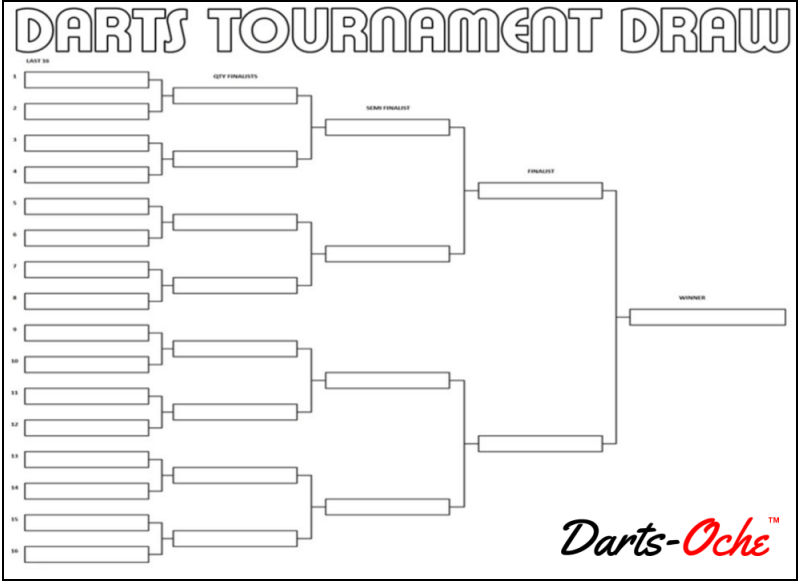Darts Draw Sheets
Dart Players Tournament Draw and Leg Scorer Sheets
Tournament Rules
Organising Darts tournaments in your local pub or club is not always easy. Players need to know the play format when they arrive and the rules for your tournament. Most Pub & Club league games use rules governed by the WDF ruling, and for a comprehensive copy of their rules, visit the WDF Website. However, to help you along, most fun tournaments can be organised without too much trauma.
Below, you will see I have produced a couple of basic tournament sheets for you to use in your local event. You can download, save and reproduce these sheets free for your tournament.
General Rules of a Standard Game of 701, 501, 301 Game
The Standard Dartboard should hang securely from a wall so that the height of the centre bull to the ground is 5ft 8ins / 173cm. (See Dartboard Set-up)
The throwing distances can vary from 7ft to 8ft 6 ins, but the standard set-up is played from 7ft 9 ¼ ins 2.37 meters from the face of the dartboard measured horizontally.
The toe-line or oche shall be clearly marked and at least 18 inches long. The toe line can be just a painted line on the ground or a securely raised line indicator such as a piece of wood or metal. The latter is preferable for the thrower as a firm edge to rest their foot against, not on top!
The order of play is either determined by a toss of a coin or by each player throwing for the centre bull, the nearest being the player that throws first (WDF ruling). PDC Bulling up is slightly different. The rules here can vary depending on the league you may be playing in; the local rules should always be observed.
When throwing for the bull, if the first thrower hits the centre bull or outer bull, the dart is usually removed before the second player throws. If the second player hits the same as the first, the bulling-up procedure starts again. If the first player's dart does not hit, either the centre bull or outer bull, then the dart remains in the board until the second player throws. If the first player's dart obstructs the bull the second player may request the marker/ref to straighten the dart. (See local rules) WDF & PDC Bullying-up procedure is different. So, observe the tournament rules.
Once the order of play has been determined, the winner will start leg one and odd legs afterwards. The loser will start leg two and even legs thereafter.
Any standard darts may be used.
A throw consists of three darts except when the game is finished in less.
Darts cannot be re-thrown. This includes darts that miss the board and bounce off the board wiring system. Only darts that have their points touching the scoring area of the dartboard score.
If they ask, a player may be told what they scored or what number they require for the game by the score announcer, but not how to achieve it. They should not ask another team member for the outshot unless this is part of the agreed rules in your local league/tournament.
If the number required for the game is exceeded during a throw, the throw ceases, and no account is taken of the score obtained.
The inner bull (50) counts as double of (25) the outer bull. (steel tip darts)
As previously agreed, the game or leg is to score 301, 501 or 701.
Generally, each player's score must start and finish a game with a double (The outer narrow ring of the board). Competition games, however, are usually played with a straight start (no compulsory double) but with a compulsory double to finish.
Scoring this tournament
The first throw is deducted from the player start number, e.g. 501 and then from the subsequent reducing total. The scorer should show both the score obtained for the throw and the reduced total remaining.
This tournament requires a double/single start.
The tournament is the first to reach _____ legs / _____sets. Each set is the best of (___) legs.
Disputes to be settled by _____________________
You may have other rules that you may wish to apply, such as match marking, i.e. looser of the previous match marks the next. You may wish to impose fines if this isn't done. You may have a team event, and usually, home teams mark.
It is your event, and you can make the rules; however, the more straightforward they are, the easier it is for all.
Downloads
Tournament draw and leg scores can be printed in A4/A3 sizes. By default, the downloads are designed for the typical printer paper size of A4. However, if you own or know someone with a printer capable of printing using A3 paper, you can adjust the print size on your printer.
Set your printer to A3 and scale up the PDF to 200% resolution. Usually, you can see a preview on your PC before you print before you print.
If you need a FREE PDF Reader click here



